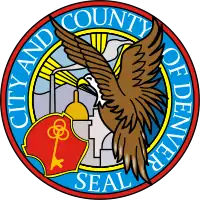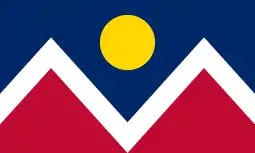Denver Fire Department
The Denver Fire Department provides fire protection and first responder emergency medical services to the city of Denver, Colorado.[3] The department is responsible for an area of 155 square miles (400 km2) with a population estimated at 690,000.[3] The Denver Fire Department also provides fire protection to the citizens of Glendale, Sheridan, Skyline and Englewood.
 | |
| "Everyone Comes Home" | |
| Operational area | |
|---|---|
| Country | |
| State | |
| City | |
| Agency overview[1] | |
| Established | 1866 |
| Annual calls | 108,911 (2014) |
| Employees | 1018(2016) |
| Annual budget | $122,304,424 (2014) |
| Staffing | Career |
| Fire chief | Desmond Fulton |
| IAFF | 858 |
| Facilities and equipment[2] | |
| Battalions | 7 |
| Stations | 39 |
| Engines | 32 |
| Trucks | 16 |
| Platforms | 6 |
| Quints | 1 |
| Rescues | 3 |
| HAZMAT | 2 |
| Airport crash | 7 |
| Wildland | 3 |
| Rescue boats | 1 |
| Light and air | 1 |
| Website | |
| Official website | |
| IAFF website | |


General Rank structure
| Rank Structure | Duties |
|---|---|
| Chief | The Executive Officer of the Fire Department.
He/she shall have overall command responsibility of the Department. |
| Deputy Chief | Next in rank below Chief of the Department. Responsible for the
day-to-day operations of the Department, acting as Chief of the Department when the Chief is unavailable. |
| Division Chief | Next in rank below Deputy Chief. Division Chiefs are appointed
by the Chief of the Department. Division Chiefs are responsible for the following Divisions:
|
| Assistant Chief | Next rank below that of Division Chief. When assigned to
Suppression, Assistant Chiefs direct rescue and firefighting activities at the command- level and manage their fire District on their shift. When assigned to support functions, they act as senior managers within their division. |
| Captain | Next in rank below Assistant Chief. When assigned to Suppression,
Captains direct the activities of their Company on their shift, may act as Assistant Chief in the absence of the assigned Chief, manage or share management of their assigned Station, and perform the duties of emergency scene command as appropriate. When assigned to support functions, they perform as senior staff members, responsible for managing their unit’s activities as assigned. |
| Lieutenant | Next in rank below Captain. When assigned to Suppression,
Lieutenants direct the activities of their company on their shift and perform the duties of emergency scene command as appropriate. When assigned to support functions, Lieutenants serve as line officers who direct and/or complete tasks within the scope of their responsibility. |
| Engineer | Next in rank below Lieutenant. Non-supervisory position subordinate to a
company officer. Engineers are responsible for the operation and assigned routine maintenance of their apparatus to which they are assigned. Engineers also perform firefighting duties as directed by their company officer. |
| Firefighter | Next in rank below Engineer. When assigned to Suppression,
firefighters are subordinate to their company officer and perform as team members that mitigate emergency situations as directed. |
| Technician | A position in either Suppression or Support Service designated by the
Chief of the Department. Prior to being appointed, Technicians demonstrate that they possess special skills, technical expertise, and/or training beyond that attained by other Firefighters. |
History
The Denver Fire Department got its start on March 25, 1866 when a volunteer fire department was organized.[4] Known as Volunteer Hook and Ladder Co. #1, the company was the first in the Colorado Territory.
Stations and apparatus
As of 2015, the Denver Fire Department operates out of 39 fire stations (including 5 Airport Stations), located throughout the city in 7 Districts, each under the command of a District Chief.[5]
| Fire Station Number | Neighborhood | Engine Company | Truck Company or Tower Company | Special Unit(s) | District Chief Unit | District |
|---|---|---|---|---|---|---|
| 1 | Downtown | Engine 1 | Tower 1 | Water Rescue, Collapse Rescue | District Chief 2 | 2 |
| 2 | Gateway | Truck 2 (Quint) | Wildland Engine | District Chief 5 | 5 | |
| 3 | Five Points | Engine 3 | 2 | |||
| 4 | Lower Downtown | Truck 4 | 2 | |||
| 5 | Glendale | Engine 5 | 3 | |||
| 6 | Auraria | Engine 6 | HAMMER 1 | 2 | ||
| 7 | Highland | Engine 7 | 6 | |||
| 8 | Capitol Hill | Engine 8 | Truck 8 | Air/Light 8 | 4 | |
| 9 | Globeville | Engine 9 | Tower 9 | Decon Unit | 6 | |
| 10 | Cole | Engine 10 | Mass Decon Unit, Mobile Command | 4 | ||
| 11 | Baker | Engine 11 | Rescue 1 | 2 | ||
| 12 | Highland | Engine 12 | Truck 12 | District Chief 6 | 6 | |
| 13 | Hampden | Engine 13 | 3 | |||
| 14 | Montclair | Engine 14 | 4 | |||
| 15 | City Park | Engine 15 | Tower 15 | District Chief 4 | 4 | |
| 16 | University of Denver | Engine 16 | Truck 16 | 3 | ||
| 17 | Berkeley | Engine 17 | 6 | |||
| 18 | Lowry | Engine 18 | 4 | |||
| 19 | Lowry | Engine 19 | Truck 19 | 4 | ||
| 20 | Barnum | Engine 20 | 6 | |||
| 21 | Washington Park | Engine 21 | 3 | |||
| 22 | Hampden | Engine 22 | Tower 22 | 3 | ||
| 23 | Westwood | Engine 23 | Tower 23 | 7 | ||
| 24 | University Hills | Engine 24 | District Chief 3 | 3 | ||
| 25 | Harvey Park | Engine 25 | 7 | |||
| 26 | Stapleton | Engine 26 | Truck 26 | Rescue 2 | 4 | |
| 27 | Montbello | Engine 27 | Truck 27 | 5 | ||
| 28 | Fort Logan | Engine 28 | Truck 28 | District Chief 7 | 7 | |
| 29 | Green Valley Ranch | Engine 29 | 5 | |||
| 30 | Grant Ranch | Engine 30 | 7 | |||
| 31 | Denver International | Tower 31 | Mini 31, Stair Unit 21, Snow Cat Mobile Command, Red 1, Red 2, Red 3 | 8 | ||
| 32 | Denver International | Engine 32 | Mini 32, DGRT, Stair Unit 22 | District Chief 8 | 8 | |
| 33 | Denver International | Red 5, Red 6, Red 8 | 8 | |||
| 34 | Denver International | Red 4 | 8 | |||
| 35 | Denver International | Engine 35 | Engine 35 | 8 | ||
| 36 | Sheridan | Engine 36 | 7 | |||
| 37 | Englewood | Engine 37 | Denver Health Paramedics Medic 837 | 7 | ||
| 38 | Englewood | Truck 38 | Denver Health Paramedics Medic 838 | 7 | ||
| 39 | Stapleton | Engine 39 | 5 |
Notable Incidents
United Airlines Flight 859
In July 1961, United Airlines Flight 859 crashed during landing at the now defunct Stapleton International Airport. The aircraft, a Douglas DC-8 airliner, slammed into several airport vehicles, including construction equipment, and caught fire, killing 18 (including one on the ground) and injuring 84 from a total of 122 people on board.[6] This incident sparked the need for the DFD to place foam engines at the airport.[4]
Continental Airlines Flight 1713
On November 15, 1987, a Douglas DC-9-14 Continental Airlines Flight 1713 crashed while taking off in a snowstorm from Stapleton International Airport.[7] Twenty-five passengers and three crew members died in the crash.
Continental Airlines Flight 1404
On December 20, 2008, Continental Airlines Flight 1404 from Denver International Airport to George Bush Intercontinental Airport crashed while taking off from Denver resulting in 2 critical injuries, 36 non-critical injuries and a hull loss of the Boeing 737-524 aircraft.[8]
References
- "Public Safety Budget - 2015". Denver Government. Retrieved 8 May 2015.
- "Stations". Denver Fire Department. Archived from the original on 29 April 2015. Retrieved 8 May 2015.
- "Denver Fire Department". 5280 Fire. Retrieved 9 May 2015.
- "Denver Fire Department History". Denver Firefighters Museum. Retrieved 9 May 2015.
- "Denver Fire Department: About Us". Denver.org. Archived from the original on August 29, 2012. Retrieved August 15, 2012.
- "ASN Aircraft accident Douglas DC-8-12 N8040U". Aviation Safety Network. Retrieved 9 May 2015.
- "ASN Aircraft accident Douglas DC-9-14 N626TX". Aviation Safety Network. Retrieved 9 May 2015.
- "ASN Aircraft accident Boeing 737-524 N18611". Aviation Safety Network. Retrieved 9 May 2015.

